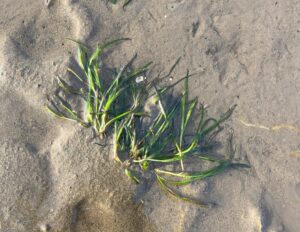Eden Estuary -Sand Dunes, Saltmarsh and Seagrass
1st December 2023
At low tide on a cold and clear morning in December, members of Project Seagrass, Restoration Forth, West Sands Ranger Service teams, along with Kim Vender (Edinburgh University), a St Andrews University student and the Green Shores team, headed out along West Sands Beach, around the Outhead point and into the Eden Estuary.

Discussion ranged from the dune erosion effects from the recent storms, referencing the amount of sand scoured off the beach; to energy transfer and rebound effect due to differing rock armor defences and their impact on the vegetation growth in front of gabions; to the suitability of the Eden estuary for seagrass growth and the spotting of some dwarf eelgrass meadows (Zostera noltii) and individual Zostera marina plants; visiting a successful saltmarsh restoration site, and potential of alternate ways to plant saltmarsh with less washout.

Eelgrass is a type of seagrass native to the UK waters, Z. marina tends to grow in deeper water and the thinner leaved Z. noltii is more often found in shallower water, so it was good to see both species on the estuary. It was noted that larger, more extensive patches of Z. noltii had been observed by the Green Shores team on the north shore of the Eden Estuary the week previously.
The Eelgrass plants above-ground vegetation dies back over winter and is washed away by tides and storms, leaving the roots in place to regrow in spring. That the Eden estuary was somewhat more protected from the recent storms than the Firth of Forth was noted, as a result we could see the seagrass growing in situ while seagrass vegetation has mostly been washed away in the Restoration Forth sites.

The end point of the walk was at a saltmarsh restoration site previously planted by Green Shores. The Sea Club Rush (Bolboschoenus maritimus) plantings have spread and started to accumulate sediment, raising ground around the plants and protecting the fragmented saltmarsh behind it from wave energy, allowing it to recover and grow.
Some sites need greater protection to ensure washout rates remain acceptable. The continued funding of Green Shores is allowing investigation of alternative methodologies to create physical barriers to protect newly planted saltmarsh and remove some of the pressures of challenging wave energy in these dynamic systems. These methods have proved successful in Dornoch Firth and it will be interesting to see how they respond in the Eden and the Tay estuary sites.